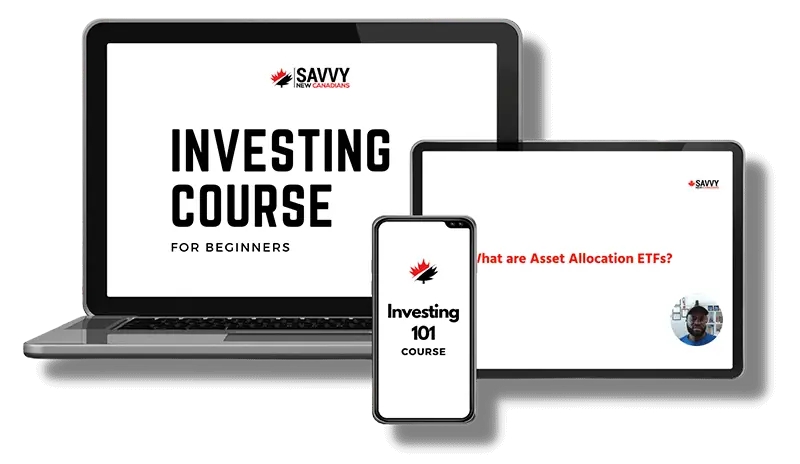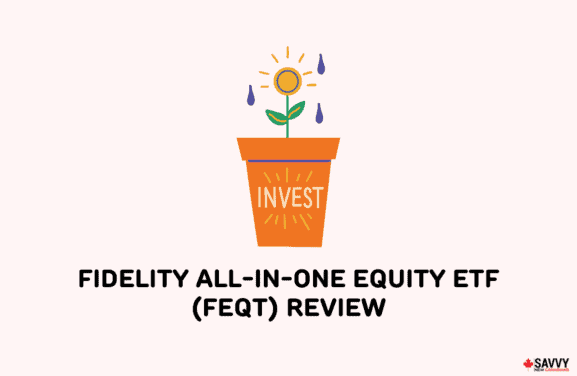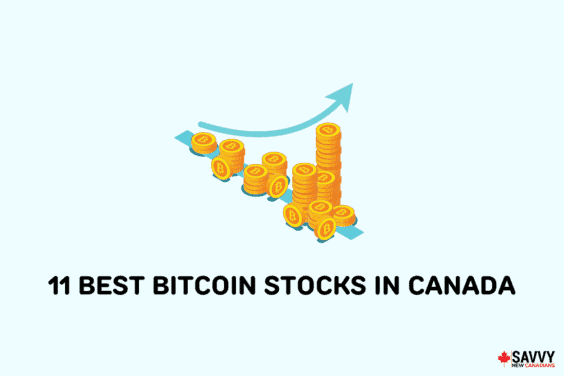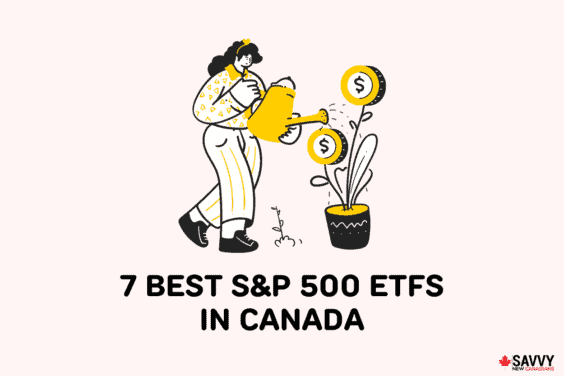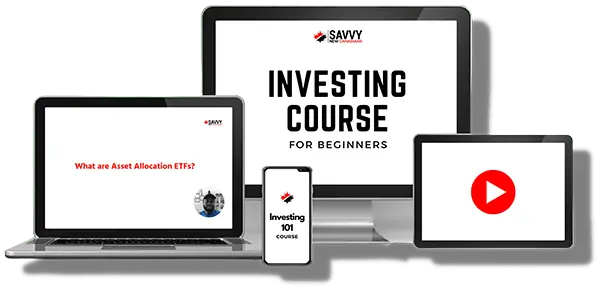For beginners, investing can be an intimidating and overwhelming concept. With so many different assets and strategies, it is difficult to choose where to start.
When it comes to investing, the most important thing is that you get started. In this article, we’ll provide a simple, step-by-step guide to investing in Canada as a beginner.
Why Invest in Canada?
Why should you consider investing? It is one of the best ways to put your money to work to build potential wealth for the future. There is always a dilemma between the risk-reward tradeoff when it comes to investing.
Generally speaking, the longer you invest your money, the greater the chance of creating wealth and seeing returns that outpace the inflation rate.
The secret to the growth of your investments is time and the power of compounding. Together, these two forces can grow your money at a substantial rate.
Of course, the alternative to investing your money is just to hold it in a savings account. The return on your savings is minimal and is almost always lower than the rate of inflation. This means that when your money is just sitting in your account, it is losing value as time goes on.
How to Invest in Canada
Self-Directed Investing
This method of investing is when you would build and manage your own investment portfolio. For beginners, this can be challenging, especially if you are new to the stock market and want to invest in stocks or ETFs.
The benefits of self-directed investing are clear. You will not incur any management fees aside from transaction fees on your brokerage or expense ratios for ETFs or mutual funds. There are no additional fees to pay to a portfolio manager.
The downsides of self-directed investing are that it can take up more of your time to research your investments. There can also be some losses in the beginning as you learn how to navigate the markets.
Robo-Advisor Services
Robo-advisor services have certainly gained popularity in recent years, and almost every brokerage in Canada offers its own robo-advisor accounts.
A robo-advisor account is a portfolio managed by human fund managers and AI algorithms. They build your investment portfolio around your investment goals.
The benefit of a robo-advisor service is that it is a set-it-and-forget-it investment strategy. It requires very little effort on your part, and you are trusting the fund managers to build you a successful investment portfolio.
When it comes to robo-advisors, the downside is that you typically pay higher management fees. This can be somewhat mitigated using low-fee investment companies like Wealthsimple Invest or Questwealth, which charge 0.20% to 0.50% annually.
Traditional Investing
Traditional investing is when you go through your bank or a financial advisor to build your investment portfolio. This is still the way that a majority of people invest in Canada.
Most people simply do not have the time to dedicate to researching investments. For these people, traditional investing works well to build their wealth.
Unfortunately, traditional investing tends to have the highest management fees. Even if your portfolio does not need to be actively managed, you will be paying 1-3% each year in fees.
On top of that, there can be additional charges like portfolio reviews and initial assessments. This is one reason why robo-advisors have become a more popular option.
Types of Investments in Canada
Stocks
When it comes to investing, most people think about buying individual stocks of companies. The denomination of the stock you buy is referred to as shares. You own stock in the company, and the percentage you own is determined by how many shares you have. The stock price we see listed is the price of one share.
Investing in the stock market for the long term has proven to be one of the surest ways to build your wealth over time. Unfortunately, you do have to pick the right stocks, and that can prove to be a challenge.
How can you choose the right stocks in Canada? This is one thing that many beginners overlook. You need to research the companies you want to invest in and keep up with news, earnings reports, and other company events.
Exchange Traded Funds (ETFs)
As the name suggests, ETFs are baskets of individual stocks that trade on the major stock exchange. These funds tend to track an underlying index or sector of stocks. This provides instant diversification to investors with a lower level of risk.
At the end of the day, ETFs are still funds, which means they are managed and charge an expense ratio to shareholders.
Unlike mutual funds, ETFs can be traded throughout the session, just like stocks. They may also pay dividends to shareholders, and you can even trade options against them. ETFs provide the stability of managed funds with the flexibility of individual stocks.
Fixed Income Securities
There is a wide variety of different fixed-income securities, but the most common ones are bonds. Other fixed-income assets include treasury bills, GICs, and banker’s acceptances.
Fixed-income securities provide a guaranteed rate of steady interest income for a set period of time. For bonds, these are usually monthly distributions. You can own different types of bonds, including government bonds, corporate bonds, and municipal bonds.
Bonds and other fixed-income securities have an inverse relationship to stocks. When the stock market is volatile, people turn to bonds, and vice versa. While fixed-income securities provide a steady return on income, there needs to be more capital appreciation on your investment.
Mutual Funds
Investors often confuse mutual funds with ETFs. While ETFs trade on the major exchanges, mutual funds are not listed and are managed by the provider, usually a bank or other financial institution. Mutual funds are also baskets of individual assets that can rise or fall in value.
They also pay distributions to unit holders, which are usually re-invested.
Mutual funds are actively managed, and their assets are frequently rebalanced. Most ETFs are passively managed as they track an underlying index. This also explains the discrepancy in fees between the two, as actively managed mutual funds typically have much higher fees.
Guaranteed Investment Certificates (GICs)
GICs are a form of fixed-income security in Canada. It is a term deposit that earns interest for a set period of time. At the end of that period, you receive back the full amount you invested plus any interest earned.
In Canada, GICs can range anywhere from 30 days to ten years. Typically the longer the term, the higher the interest earned on your investment. The risk level for GICs is low, given that you get back your original investment amount at the end of the term.
Real Estate
Real estate is another popular investment asset in Canada. Canadians can own property to live in or rent out to tenants. There are barriers to entry in Canadian real estate, including qualifying for a mortgage and saving up enough for a downpayment.
Alternatively, you can invest in Canadian REITs or Real Estate Investment Trusts. These are companies that are listed on the TSX that own residential or commercial real estate. Investing in these gives you exposure to the company’s rental income, which is paid out through a distribution.
Cryptocurrency
Cryptocurrencies are the most volatile and unpredictable investment assets in Canada. They are completely digital and need to be purchased through a crypto exchange. Crypto markets have no physical location, so they are open 24 hours per day, seven days per week, and 365 days per year.
Most people have heard of the largest two cryptos by market cap: Bitcoin and Ethereum. But there are tens of thousands of cryptocurrencies on the market, including other major tokens like MATIC, Solana, Shiba Inu, and DogeCoin.
While they are referred to as cryptocurrencies, they have limited use as actual currencies and are used more as investment assets.
Forex
Forex or Foreign Exchange trading is an advanced form of investing that aims to make a profit off of the fluctuations in different global currencies. The trading markets for forex are open 24 hours per day and five and a half days per week.
Forex traders can trade in spot markets or in futures markets if they want to speculate on the price action of various currencies.
Options and Futures
Options and futures are derivatives of exchange-traded assets. Both are contracts that provide the ability but not the obligation to buy assets at a given price on a future date.
Options trading is popular because it allows you to potentially earn higher returns on lower initial capital. When you trade options, you are making a speculative bet on the direction of the price of the underlying stock.
Most Canadian brokerages require an application to trade options. This is because options can be risky, with near-unlimited losses in the wrong situation. Options can be both bought or sold as a speculative trade or as a hedge for the holdings in your portfolio. Before trying to trade options, try practicing in a paper trading account first.
What To Consider Before Investing
Pay Off High-Interest Debt
Before you start allocating your money to an investment account, it is wise to take care of any debts you might carry. This is especially true for high-interest debts like credit card debt or personal loans. Any gains you make from investing will be more than mitigated by these types of high-interest debts.
This does not include debts like a mortgage, a car loan, or student loans, to name a few. It is fine to invest while paying off these low-interest-rate debts.
Create an Emergency Fund
The further you get in life, the more critical it is to have access to emergency cash. It is advised to have 3-6 months’ worth of expenses saved in your emergency savings account. This can help cover anything from your car breaking down to a plumbing mishap in your house.
These days, you can hold your emergency fund in a high-interest savings account and earn a great interest rate on your cash.
Determine Your Risk Tolerance
Before investing any money, you should know what your limits are when it comes to taking risks. There are investment assets for every type of risk tolerance, so only invest in what feels comfortable. Taking risks with investing is a fast way to lose your money!
Decide Your Investment Goals
What are you investing for? It could be to have a comfortable retirement, to buy a new house, or to leave money for your children. Make sure that before you ever invest a penny of your hard-earned money, you know exactly what your goals are.
How Much Should I Invest?
Choosing the right amount to invest can be confusing to understand. On the one hand, some people will say to invest as much as you can to grow your wealth. Others will say invest what you can afford to lose.
When you are younger and have fewer costs, it helps to invest as much as you can. It is easier to contribute larger amounts before you have a mortgage or kids to pay for. As you get older, invest what you can after all of your bills and payments are made.
Choose an Investment Account
In Canada, there are two types of investment accounts: registered and non-registered. Registered accounts include TFSAs, RRSPs, RESPs, and FHSAs. These are designed to help Canadians invest for the future in a tax-friendly manner.
TFSAs are completely tax-free for any interest, dividends, or capital gains you earn. RRSPs and RESPs are tax-deferred until you need to cash these investments out. FHSAs provide a tax-friendly way of saving for your first home. All of these accounts have annual contribution limits.
Non-registered accounts are your regular brokerage investment accounts. Your everyday non-registered investment account is called a cash account. You can also apply for a margin trading account that uses your existing investments as collateral to provide additional investment funds to your account.
When using margin, you will need to pay interest on the amount borrowed from your brokerage.
Choose a Brokerage Platform
Not all brokerages are equal, especially in Canada, where the big banks have traditionally dominated the investment industry. The problem with the big banks is that they charge extremely high trading fees. They know that most people bank with them, so it is convenient to just transfer money to their brokerage account as well.
There is a growing number of discount brokerages that are gaining popularity, especially among the younger, tech-savvy crowd. Sites like Questrade, Qtrade, and Wealthsimple offer almost everything that the big banks do for a fraction of the price.
Other factors to consider include the availability of assets like options, foreign stocks, and even cryptocurrencies. Discount brokerages might have lower trading fees but can also have fewer investment assets or listed stocks.
Questrade
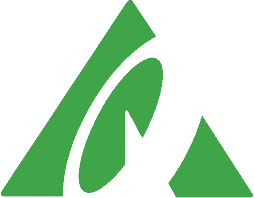
Trade stocks, ETFs, options, FX, bonds, CFDs, mutual funds, etc.
Get $50 trade credit with $1,000 funding
Low and competitive trading fees
No quarterly inactivity fees
Access to advanced tools and trading data
Top platform for advanced traders
Transfer fees waived
Qtrade

Up to $150 sign-up bonus
Trade stocks, ETFs, options, bonds, etc.
Excellent platform for newbies and seasoned investors
Competitive trading fees
Excellent customer service
Active vs Passive Investing
For most beginners, passive investing is a great way to start investing. This requires little work once you have invested your money. Just leave your investments to compound over time.
A safer way to invest passively is to buy index funds and reinvest the dividends for years. If you do not have the time to keep up with your investments, then passive investing will serve you well.
Active investing requires a lot more time and effort. The benefit is that when done correctly, active investing has the potential for much larger gains than passive investing in a shorter amount of time. There is also a higher chance of incurring losses when you try to make too many trades.
How Are Investments Taxed in Canada?
In non-registered accounts, investments are taxed as a percentage of your capital gains or losses. Capital gains are when you make a profit in the time between buying the asset and selling it.
When you make a capital gain on your investment in Canada, 50% of that capital gain is added to your taxable income. Your personal tax rate is then applied to your total taxable income for the year.
If you receive dividends, distributions, or interest in a non-registered account, that is also included in your taxable income.
Investment Tips for Beginners in Canada
Invest for the Long-Term
Too many beginners get into investing with the hopes of getting rich overnight. Investing is a long-term game that requires patience and sticking to a system. The market will always have ups and downs, but if you can stay invested for the long term, there is a higher chance of growing your wealth.
Diversify Your Portfolio
Your investment portfolio does not just need to be focused on one asset. A truly diversified portfolio will own various assets, including stocks, ETFs, and fixed-income securities. This diversification can help protect your investments against downside risk when the markets are volatile.
Utilize Registered Accounts
In Canada, registered accounts are perfect for tax-friendly investing. At the very least, maximize your contributions to your TFSA each year as a starting point. Contributions to your RRSP are tax-deductible, which certainly helps if you are a high-income earner.
Focusing on maxing out your registered contributions each year can give you a great, tax-free headstart to investing!
Glossary of Investment Terms
Bonds
A bond is a fixed-income security that is like a loan you can make to a borrower like a corporation or government. In exchange, the borrower pays you a regular cash flow of interest payments until the maturity date when the initial investment is paid back.
Capital Gains
Capital gains are a calculation of the profit made during the time between buying and selling an asset. These are typically calculated for tax purposes as capital gains in a non-registered Canadian account are added to your annual taxable income.
Commodities
Commodities are a way of investing in natural resources like oil, gold, and agricultural products. You can invest in commodities through stocks, ETFs, or futures contracts. Canada is rich in natural resources and is a large producer of many different commodities.
Dividend
Dividends are distributions of corporate earnings paid out to shareholders of the stock. These distributions are paid out on a monthly, quarterly, or even annual basis.
ETFs
ETFs or Exchange Traded Funds are baskets of assets like stocks or bonds that typically track a broader index or sector. ETFs pay dividends to shareholders and charge a management fee called an MER or Management Expense Ratio.
Index Fund
An index fund is an ETF or mutual fund that tracks a specific index like the S&P/TSX 60, the S&P 500, or the NASDAQ composite index. These are passively managed funds that tend to have lower management fees and MERs.
Margin
Margin is using borrowed money from your brokerage to invest in assets like stocks or ETFs. The brokerage uses your existing investments or cash as collateral and will charge interest on the amount you borrow.
Market Capitalization
The market capitalization is the value of a publicly traded company according to its total number of shares. Calculate a market cap by multiplying the total number of shares by the current price of the stock.
Options
In investing, options are derivative contracts of the underlying asset which provide you with the right, but not the obligation, to buy or sell the asset at a given price by a pre-determined date. You can buy or sell both call and put options in a variety of different options strategies.
Registered Retirement Savings Plan (RRSP)
This is another Canadian registered investment account aimed at growing wealth for retirement. Contributions have an annual limit and are tax-deductible for that tax year. Capital gains are tax-deferred, which means they are not taxable until the investments are withdrawn from the account.
Stocks
Stocks are investments that represent partial ownership of a publicly traded company. They are divided into shares, which are held in your brokerage account. One share is equal to the stock price of the company.
Tax-Free Savings Account (TFSA)
This is a Canadian registered savings and investment account that provides a set contribution amount each year that is completely tax-free. This includes any capital gains, dividends, or interest earned in that account. As of 2024, the lifetime contribution limit for TFSAs is $95,000.
